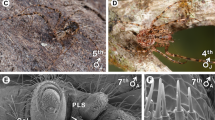Summary
The spinning apparatus of the uloborid spider Polenecia producta was studied to complete previous studies on the same family of spiders. The structure of spinnerets and spigots, under scanning electron microscopy, and the main anatomical and histochemical characteristics of the spinning glands of adult females and males are described. In addition some observations on the spinning apparatus at three successive stages of development are made. There are nine kinds of silk glands in Polenecia, i.e. one more (aciniform — B glands) than found in other uloborids. The spinning apparatus of Polenecia is, therefore, the most complex so far known. It is also more complex than that presently known of Araneoidea. The characteristics of the spinning glands of Polenecia are compared with those of other uloborids. Present knowledge of the spinning apparatus of uloborids leads to a renewed discussion of the origin of the orb web in this family and in araneids. It is concluded that these two types of orb webs emerged from independent evolutionary processes.
Similar content being viewed by others
References
Adams CWM (1956) A stricter interpretation of the ferric ferricyanide reaction, with particular reference to the demonstration of protein-bound sulphydryl and disulphide groups. J Histochem Cytochem 4:23–35
Coddington J (1986) The monophyletic origin of the orb web. In: Shear WA (ed) Spiders. Webs, behavior, and evolution. Stanford University Press, Stanford, pp 319–363
Gabe M (1968) Techniques histologiques. Masson, (ed). Paris, p 1113
Glatz L (1973) Der Spinnapparat der Orthognatha (Arachnida, Araneae). Z Morphol Tiere 75:1–50
Kovoor J (1972) Étude histochimique et cytologique des glandes séricigènes de quelques Argiopidae. Ann Sci Nat Zool [Ser 12] 14:1–40
Kovoor J (1977a) Donneés histochimiques sur les glandes séricigènes de la veuve noire Latrodectus mactans Fabr. (Araneae, Theridiidae). Ann Sci Natl Zool 12 sér 19:63–87
Kovoor J (1977b) L'appareil séricigène dans le genre Uloborus Latr. (Araneae, Uloboridae): I. Anatomie. Rev Arachnol 1 (3):89–102
Kovoor J (1978) L'appareil séricigène dans le genre Uloborus Latr. (Araneae, Uloboridae): II. Données histochimiques. Ann Sci Nat Zool [Ser 12] 20:3–25
Kovoor J (1986) L'appareil séricigène dans les genres Nephila Leach and Nephilengys Koch: anatomie microscopique, histochimie, affinités avec d'autres Araneidae. Rev Arachnol 7:15–34
Kovoor J, Lopez A (1980) Variation de l'appareil séricigène dans la famille des Araneidae: cas des genres Cyclosa Menge et Nemoscolus Simon. C R 5 Reun Arachnol Fr Barcelone: 119–127
Kovoor J, Lopez A (1982) Anatomie et histologie des glandes séricigènes des Cyrtophora (Araneae, Araneidae): affinités et corrélations avec la structure et la composition de la toile. Rev Arachnol 4:1–21
Lillie RD (1965) Histopathologic technic and practical histochemistry. McGraw-Hill, New York
Lillie RD, Fullmer HM (1976) Histopathologic technic and practical histochemistry, 4th edn. Mc Graw-Hill, New York
Lubin YD (1986) Web building and prey capture in the Uloboridae. In: Shear WA (ed) Spider-webs, behavior, and evolution. Stanford University Press, Stanford, pp 132–171
McManus JFA (1946) The histological demonstration of mucus after periodic acid. Nature 158:202
Mikulska L (1967) The external spinning structures on the thelae of the spider Argiope aurantia. Zool Pol 17:357–366
Mikulska L (1969) Variability of the number of external spinning structures in female spiders Clubiona phragmitis, C.L. Koch. Zool Pol 19:279–292
Mowry RW (1956) Alcian blue technics for the histochemical study of acidic carbohydrates. J Histochem Cytochem 4:407–408
Pearse AGE (1958) Histochemistry: I. Theoretical and applied. Little Brown, Boston
Peters HM (1982) Wie Spinnen der Familie Uloboridae ihre Beute einspinnen und verzehren. Verh Naturwiss Ver, Hamburg [NF] 25:147–167
Peters HM (1983) Struktur und Herstellung von Fangfäden Cribellater Spinnen. Verh Naturwiss Ver, Hamburg [NF] 26:241–253
Peters HM (1984) The spinning apparatus of Uloboridae in relation to the structure and construction of capture threads (Arachnida, Araneidae). Zoomorphology 104:96–104
Peters HM (1987) Fine structure and function of capture threads. In: Nentwig W (ed) Ecophysiology of spiders. Springer, Berlin Heidelberg New York London Paris Tokyo, pp 187–202
Peters HM, Kovoor J (1980) Un complément à l'appareil séricigène des Uloboridae: le paracribellum et ses glandes. Zoomorphology 96:91–102
Peters HM, Kovoor J (in press) Die Herstellung des Eierkokons bei der Spinne Polenecia producta (Simon 1873) in Beziehung zu den Leistungen des Spinnapparates. The construction of eggcases by the spider Polenecia producta (Simon 1873) in relation to the functions of the spinning apparatus. Zool Jb Physiol
Solcia E, Capella C, Vassallo G (1969) Lead haematoxylin as a staining for endocine cells. Significance of staining and comparison with other selective methods. Histochemie 21:116–126
Wasowska S (1966) Comparative morphology of the spinning fields in females of some spider species. Zool Pol 16:9–30
Wasowska S (1967) The variability of the number of external spinning structures in spiders of the genus Tibellus Simon (Thomisidae). Zool Pol 17:3–15
Wasowska S (1969) Particularités de l'appareil séricigène des mâles de Clubiona phragmitis, C.L. Koch. Zool Pol 19:506–515
Wasowska S (1970) Structures fileuses extérieures sur les filières (thelae) de l'Araignée Argiope brunnichi (Scopoli). Zool Pol 20:257–268
Wiehle H (1927) Beiträge zur Kenntnis des Radnetzbaues der Epeiriden, Tetragnathiden und Uloboriden. Z Morphol Ökol Tiere 8:468–537
Yasuma A, Ishikawa T (1953) Ninhydrin-Schiff and alloxan-Schiff staining. J Lab Clin Med 41:296–299
Author information
Authors and Affiliations
Rights and permissions
About this article
Cite this article
Kovoor, J., Peters, H.M. The spinning apparatus of Polenecia producta (Araneae, Uloboridae): Structure and histochemistry. Zoomorphology 108, 47–59 (1988). https://doi.org/10.1007/BF00312214
Received:
Issue Date:
DOI: https://doi.org/10.1007/BF00312214




